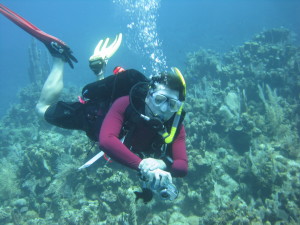Peak Performance Buoyancy
Buoyancy control. You learned the basics in Open Water Diver, but how long ago was that? Have you practiced recently? Some of the most experienced divers I know still use the first dive or two on a dive trip to fine-tune their buoyancy control.
Why is buoyancy control so important? For several reasons.
- To keep from hitting sensitive aquatic life or stirring up the bottom
- To make diving as effortless as possible
- To reduce how much air you use and extend your bottom time.
- To allow you to participate in other specialty diving activities such as photography and videography with threatening the sensitive aquatic life.
- To help streamline your profile in the water
One of the top ten things you can do to protect the aquatic world while diving is to become a buoyancy master. The Peak Performance Buoyancy Specialty course guides you through ways to perfect your buoyancy control. You can try to figure it all out on your own, or you can take the fast track with professional guidance.
Good buoyancy control starts with proper weighting. Proper weighting varies based on you and your scuba kit. For example, if you’re diving a 95cf steel tank, you may not need as much lead in your weight system compared to using an 80cf aluminum tank, even though they look similar in size. Your dive environment and exposure protection play a big part in your weighting, too. Diving warm tropical waters with just your swimsuit or a shorty wetsuit might require only a few pounds of weight. Diving the colder waters of the Pacific Northwest, though, with a drysuit and heavy undergarments might require 25+ pounds of weight. Regardless, you’ll learn how to estimate how much weight you need and then how to test if it is enough with a buoyancy check.
If you’re diving colder waters and have a lot of weight, you may want to split up the weight between different weight systems. For example, you could put fifteen pounds in an integrated weight system in your BCD and combine that with ten pounds on a belt. You’ll learn about weight systems and how to use them to balance the weight you’re carrying.
Weighting is important, but distribution of that weight can dictate your position in the water. For most diving, you often want to be in a prone position, laying horizontal, face-down so you can see what’s below you. Other times, you may want to be vertical, such as on a wall dive. How you distribute weight changes your position in the water. If you weight yourself to be vertical, but really want to be horizontal, you may spend your dive working hard to maintain position. You’ll learn how to use trim weights and where to position them. For safety, though, you will want to make sure you can ditch at least part of your weight. The great news is that if you split the weight between systems, you’ll only need to ditch one system to gain buoyancy rather than dropping it all.
Okay, you got into scuba because it was fun. Peak Performance Buoyancy also integrates some workshops and games to help you practice and tune your buoyancy control. It’s not all lecture; we play games, too.
Peak Performance buoyancy requires two open water dives. On those dives, you’ll practice what you learned in class and in confined water, adjusting your trim and practicing hovering and how to approach things underwater without crashing into them.
Make yourself a better diver and help protect our delicate aquatic resources. Become a Buoyancy Master with the PADI Peak Performance Buoyancy Specialty; one of the ten things you can do as a diver to protect our ocean planet.

